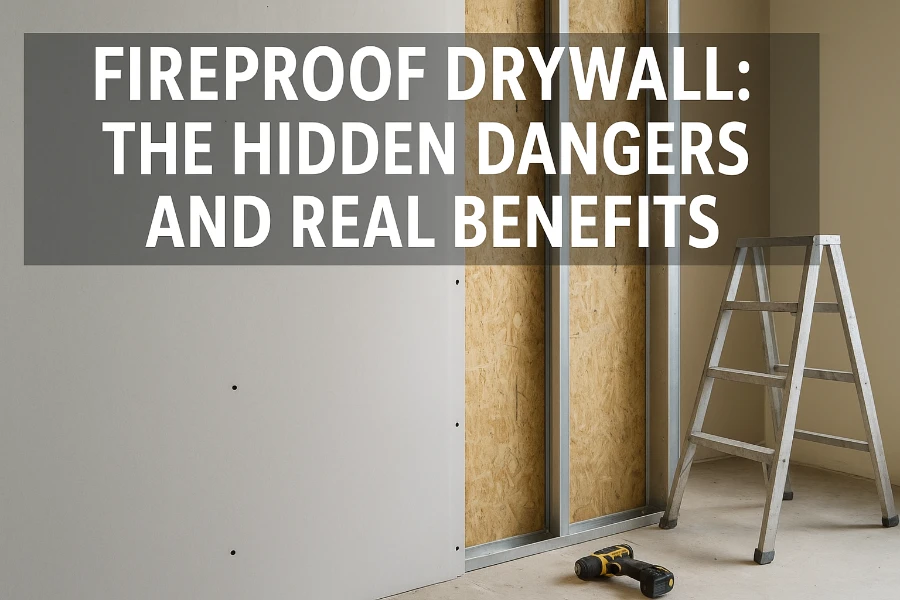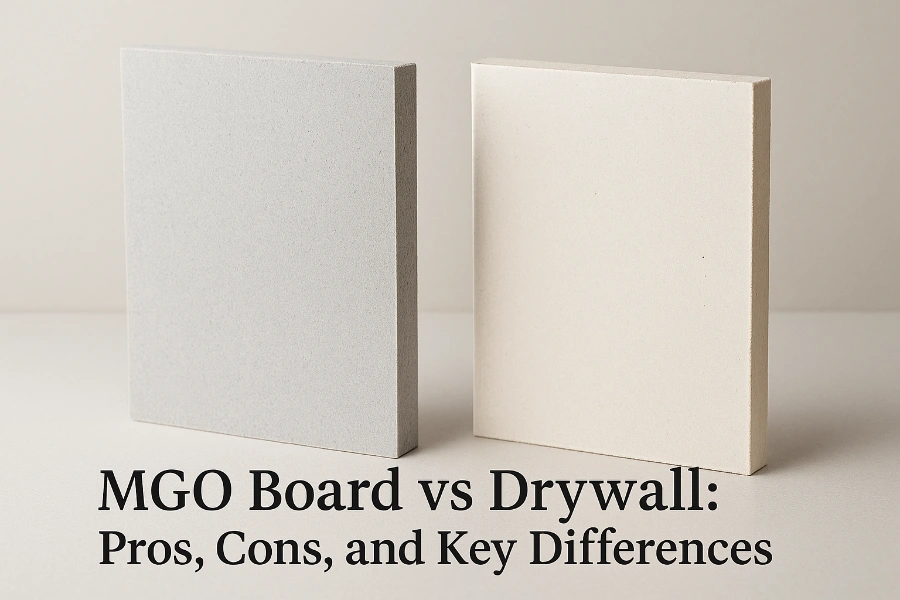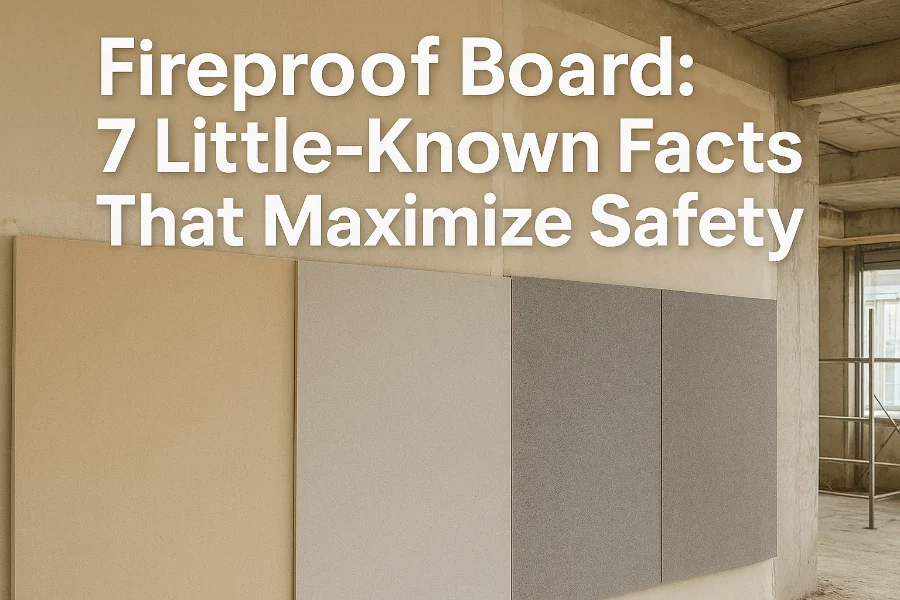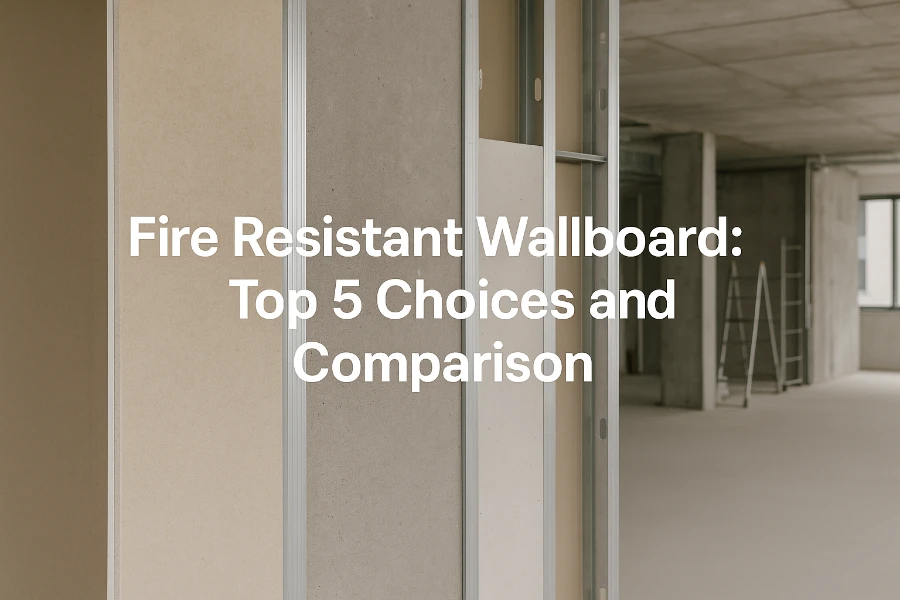Table of Contents
Introduction
Fire safety is a top priority in modern construction, whether in residential, commercial, or industrial projects. Walls and partitions play a critical role in slowing the spread of flames, protecting both lives and property. Among the many options available, fireproof drywall has become a popular choice due to its affordability and basic fire-resistant properties.
However, not all fireproof materials are created equal. While fireproof drywall offers clear cost advantages, it comes with hidden limitations that can impact durability, moisture resistance, and long-term performance. This article explores both the hidden dangers and real benefits of fireproof drywall, helping builders, architects, and homeowners make informed decisions when planning their projects.
What Is Fireproof Drywall?
Fireproof drywall (gypsum board) is a specially formulated wallboard designed to resist fire and heat for a certain period. Unlike regular drywall, it contains additives such as glass fibers, vermiculite, or special gypsum blends that improve fire resistance. These materials help the drywall maintain its structure under high temperatures, slowing down the spread of flames.
There are several types of fireproof drywall commonly used in construction. Standard gypsum-based fireproof boards are widely available and affordable, making them a practical choice for many projects. Some variations include moisture-resistant or mold-resistant layers, providing additional protection in humid environments.
Key materials in fireproof gypsum board typically include gypsum, reinforced fibers, and fire retardant chemicals. The composition may vary depending on the fire rating or the manufacturer’s specifications.
Compared to regular drywall, fireproof drywall offers enhanced safety, improved durability, and in some cases, better sound insulation. However, it is important to remember that while it improves fire resistance, it is not completely fireproof under extreme conditions. Proper installation and maintenance remain critical to its effectiveness.
Hidden Dangers of Fireproof Drywall
While fireproof drywall can enhance safety, it is not without potential risks. One common issue arises from improper installation. Gaps, poorly sealed joints, or incorrect fasteners can compromise the board’s fire resistance, reducing the overall protection of walls and partitions.
Another concern is moisture and mold. Even though some fireproof drywall variants include moisture-resistant layers, prolonged exposure to humidity or water can lead to warping, weakening, or mold growth. Over time, this may reduce both the structural integrity and the effectiveness of the fire protection.
Fire resistance is often misunderstood. Many people assume that fireproof drywall can withstand any fire indefinitely. In reality, its protective duration is limited and depends on the thickness, type, and proper installation. Overestimating its capabilities can create a false sense of security.
Additionally, some fireproof drywall may contain chemicals that could pose health or environmental concerns if not handled or disposed of correctly. Awareness of these materials and adherence to safety guidelines are important for anyone using these boards in construction.
By understanding these hidden dangers, builders and homeowners can take precautions to ensure fireproof drywall performs as intended, avoiding costly mistakes and potential safety hazards.
Real Benefits of Fireproof Drywall
Fireproof drywall offers several important benefits that make it a popular choice in modern construction. One of the primary advantages is enhanced fire resistance. Properly installed fireproof gypsum board can slow the spread of flames, giving occupants valuable time to evacuate and reducing overall property damage.
Another key benefit is durability. Fireproof gypsum board is generally stronger than regular drywall, with reinforced fibers and fire-resistant additives that help it maintain structural integrity under stress. This makes it suitable for use in high-risk areas such as kitchens, utility rooms, and commercial buildings.
In addition to fire protection, many fireproof drywall options provide improved sound insulation and moderate moisture resistance. These properties make it versatile for a range of indoor applications, from residential walls to office partitions.
Finally, fireproof drywall is widely available and cost-effective. Its affordability allows builders to implement fire safety measures without significantly increasing project costs. Combined with easy installation and compatibility with standard construction techniques, it remains a practical solution for enhancing safety in various building projects.

Choosing the Right Fireproof Drywall
Selecting the right fireproof drywall depends on multiple factors, including fire rating, moisture resistance, durability, and budget. Not every project requires the same level of protection, so understanding the differences between available options is essential.
Cost vs Performance
Standard fireproof drywall is generally affordable and provides adequate fire resistance for most residential and commercial projects. Its main advantage lies in cost-effectiveness, making it a practical choice when budget constraints are significant.
However, for projects where higher strength, superior fire resistance, or enhanced moisture protection is required, alternatives like magnesium oxide (MgO) boards can offer significant benefits. MgO boards outperform fireproof drywall in durability, fire rating, and resistance to humidity, although they typically come at a higher price. Depending on the project’s needs, a careful balance between performance and cost should guide the selection process. This ensures safety and longevity without exceeding budget limitations.
Certifications and Standards
When choosing any fireproof drywall, it is important to verify relevant certifications and fire ratings. Standards such as ASTM, ISO, or local building codes provide guidance on fire resistance and performance. Ensuring compliance helps prevent safety risks and guarantees that the chosen material meets project requirements.
Installation Tips and Best Practices
Proper installation is crucial to ensure that fireproof gypsum board performs as intended. Even the best materials can fail if they are not installed correctly. One of the most important steps is ensuring that all seams, joints, and edges are properly sealed. Gaps or loose boards can reduce fire resistance and compromise safety.
It is also essential to use the correct fasteners and follow manufacturer guidelines for spacing and support. Over-tightening screws or nails can damage the board, while insufficient fastening may lead to sagging or separation over time.
Moisture management is another key consideration. Fireproof drywall may resist some humidity, but prolonged exposure to water can lead to warping or mold growth. Using moisture-resistant variants in bathrooms, kitchens, or basements can help mitigate these risks.
When deciding between professional installation and DIY, it is generally recommended to hire trained contractors, especially for larger or high-risk projects. Professionals are familiar with fire codes, proper fastening techniques, and finishing methods that maximize the drywall’s effectiveness.
By following these best practices, you can ensure that fireproof drywall provides optimal protection, durability, and long-term performance, giving you peace of mind in any construction project.
Conclusion
Fireproof drywall offers a practical solution for enhancing fire safety in residential, commercial, and industrial buildings. It provides improved fire resistance, durability, and moderate moisture protection, all while remaining cost-effective and easy to install. Understanding its limitations—such as potential moisture issues, installation challenges, and finite fire resistance—is essential for ensuring its effectiveness.
For projects requiring higher strength, longer-lasting fire protection, or superior moisture resistance, materials like magnesium oxide (MgO) boards can serve as a valuable alternative, offering enhanced performance where needed. Balancing cost and performance based on your project’s specific requirements is key to achieving both safety and efficiency.
To ensure your construction project meets the highest fire safety standards, careful material selection and professional installation are crucial. If you want expert advice or high-quality fireproof gypsum board and MgO boards for your project, contact our team today. We provide tailored solutions to match your safety, performance, and budget needs.
Compare MGO board vs drywall to understand their pros, cons, and key differences. Discover which wall material suits your project best.
Discover 7 little-known facts about fireproof boards that enhance safety, durability, and versatility. Learn how to protect buildings effectively.
Discover the top 5 fire resistant wallboard options, compare performance, durability, and applications to choose the best solution for safer construction.




